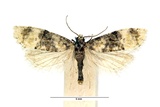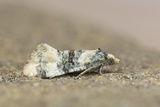Thyraylia nana (Haworth, 1811) Species
Last modified: Nov. 22, 2025, 5:11 p.m.
A fairly common species throughout Belgium.
Details
- Classification
- Family: Tortricidae > Subfamily: Tortricinae > Tribus: Cochylini > Genus: Thyraylia > Species: Thyraylia nana
- Vernacular names
- Vroege dwergbladroller (NL), Birch Conch (EN), Früher Zwerg-Birkenwickler (DE)
- Synonyms
- Thyraylia carneana (Guenée, 1845)
- First mention in Belgium
- De Fré Ch. 1858. Catalogue des Microlépidoptères de la Belgique. — Annales de la Société entomologique belge 2: 45–162. On page 97.
- Status
-
Native
Distribution
Imago
Wingspan 9–13 mm. Distinctive small species with grey/ochreous general coloration, and the broad dark brown and black median fascia of the forewing with its outer margin outward-oblique from the costa and the inner margin diffuse and often confluent with the ill-defined basal fasciae. Palps and head are grey.
Caterpillar
Dirty yellowish-white body with a brown dorsal line, head brown, prothoracic plate brownish, rear part darkly punctuated.
Bionomics
The larva lives in a female catkin and hibernates full-fed from October in a cocoon spun in a bark crevice. Pupation in the cocoon.
The moths are active around Betula trees at dusk and occasionally come to light.
Flight periods
The adults have been observed from late April till mid-June with a peak during May. A partial generation occurs from late June towards September.
Habitat
It inhabits woodland containing Betula.







